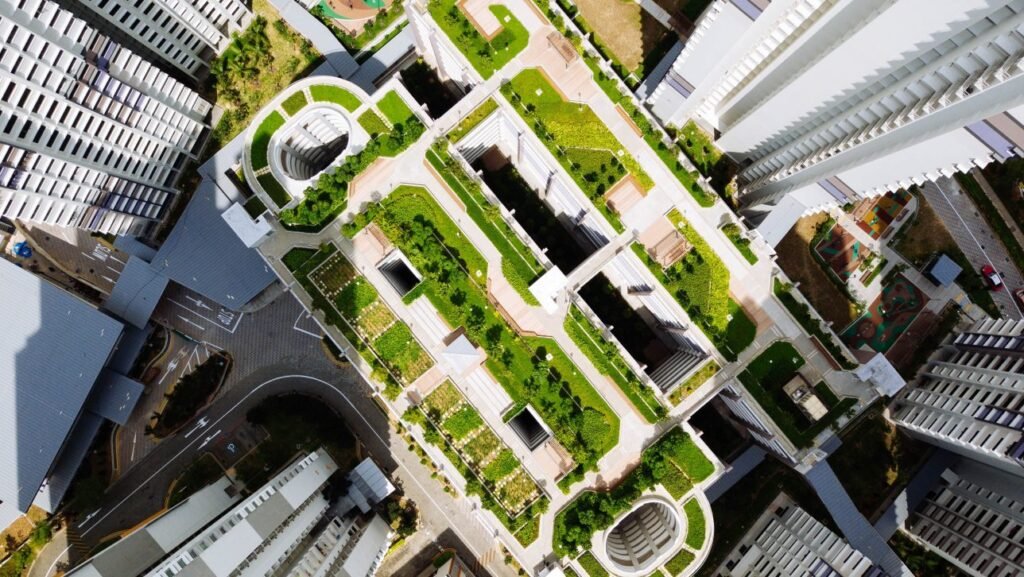Imagine living in an apartment building surrounded by lush greenery, with a garden right above your head. It might sound like a dream, but with the rise of sustainable solutions, green roofs for apartment buildings are becoming a reality. These innovative rooftop gardens not only enhance the visual appeal of the building but also offer numerous environmental benefits. From improving air quality to reducing energy consumption, green roofs are revolutionizing urban living by bringing nature back into our concrete jungles. In this article, we will explore the incredible advantages of green roofs for apartment buildings and how they are transforming the way we think about sustainable living.
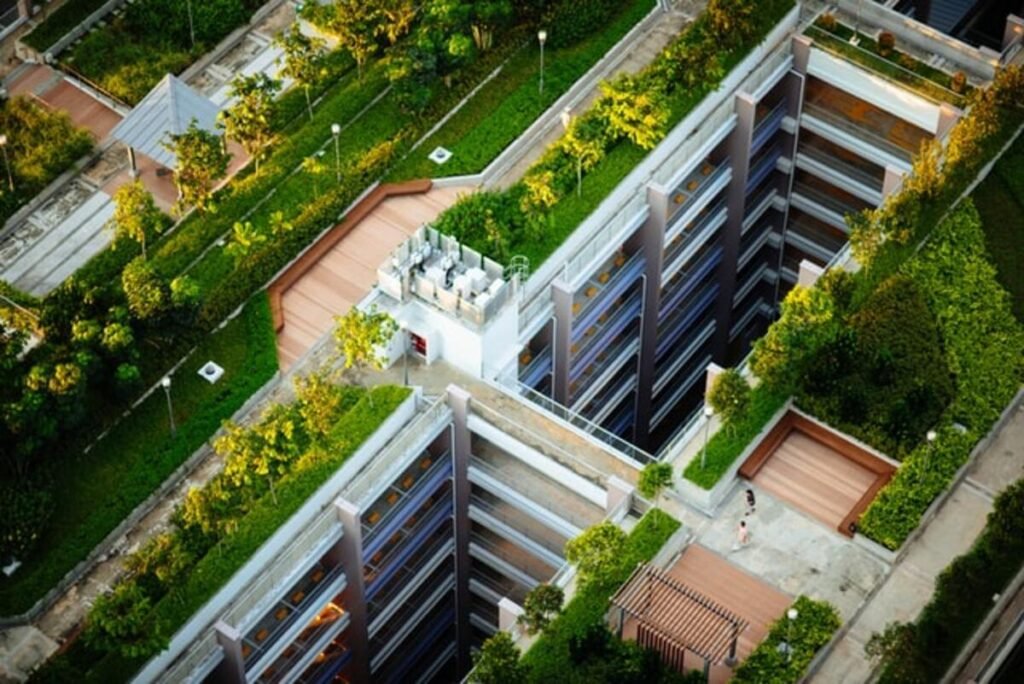
This image is property of www.construction21.org.
Benefits of Green Roofs for Apartment Buildings
Reduced Energy Consumption
One of the key benefits of green roofs for apartment buildings is the reduced energy consumption. Green roofs provide natural insulation, helping to keep the building cooler in the summer and warmer in the winter. This insulation reduces the need for air conditioning and heating, resulting in lower energy bills for the residents. In addition, green roofs also absorb heat and reduce the urban heat island effect, further contributing to energy savings.
Improved Air Quality
Green roofs can significantly improve the air quality in apartment buildings. The vegetation on the roofs filters harmful pollutants and particulate matter from the air, reducing the amount of pollutants that residents breathe in. Green roofs also absorb carbon dioxide and release oxygen, helping to mitigate air pollution and combat climate change. By improving air quality, green roofs create a healthier living environment for apartment residents.
Reduced Stormwater Runoff
Stormwater runoff can cause flooding and overwhelm sewage systems, leading to water pollution. Green roofs act as natural sponges, absorbing and retaining rainwater. This reduces the amount of stormwater runoff, alleviating the strain on drainage systems and reducing the risk of flooding. By retaining and filtering rainwater, green roofs also contribute to water conservation and help to replenish groundwater sources.
Enhanced Biodiversity
Green roofs provide valuable habitat for plants, insects, birds, and other wildlife. By incorporating native and drought-tolerant plants, green roofs can attract a diverse range of species and support local biodiversity. This is particularly important in urban areas, where natural habitats are limited. By providing a green oasis, green roofs can help to preserve and promote biodiversity in apartment buildings.
Extended Lifespan of Roofing Materials
The vegetation and soil layer of green roofs act as a protective barrier, shielding the roofing materials from UV radiation, temperature fluctuations, and extreme weather conditions. This, in turn, extends the lifespan of the roof, reducing the need for frequent repairs or replacement. Green roofs also reduce the amount of wear and tear on the roof, as the vegetation absorbs and disperses rainwater, preventing pooling and leakage. Overall, green roofs can significantly increase the longevity of roofing materials, saving both money and resources.
Types of Green Roofs
Extensive Green Roofs
Extensive green roofs are lightweight and have a shallow planting depth, typically ranging from 2 to 6 inches. These roofs are ideal for buildings with limited structural capacity, as they impose minimal weight on the structure. Extensive green roofs are low-maintenance and are often covered with drought-tolerant plants, such as sedums and other succulents. They require less irrigation and are suitable for areas with limited access to water.
Intensive Green Roofs
Intensive green roofs are more substantial and have a deeper planting depth, typically ranging from 6 to 12 inches or more. These roofs can support a wide variety of plants, including shrubs, trees, and even small gardens. Intensive green roofs require more maintenance and irrigation but offer greater opportunities for recreational use and aesthetic appeal. They provide a lush and vibrant green space for residents to enjoy, creating a mini-park on the rooftop.
Semi-Intensive Green Roofs
Semi-intensive green roofs combine elements of both extensive and intensive green roofs. They have a moderate planting depth, typically ranging from 4 to 8 inches. Semi-intensive green roofs allow for a greater variety of plants compared to extensive green roofs but require less maintenance than intensive green roofs. These roofs strike a balance between aesthetics and practicality, providing a visually appealing green space while minimizing the resources needed for maintenance.
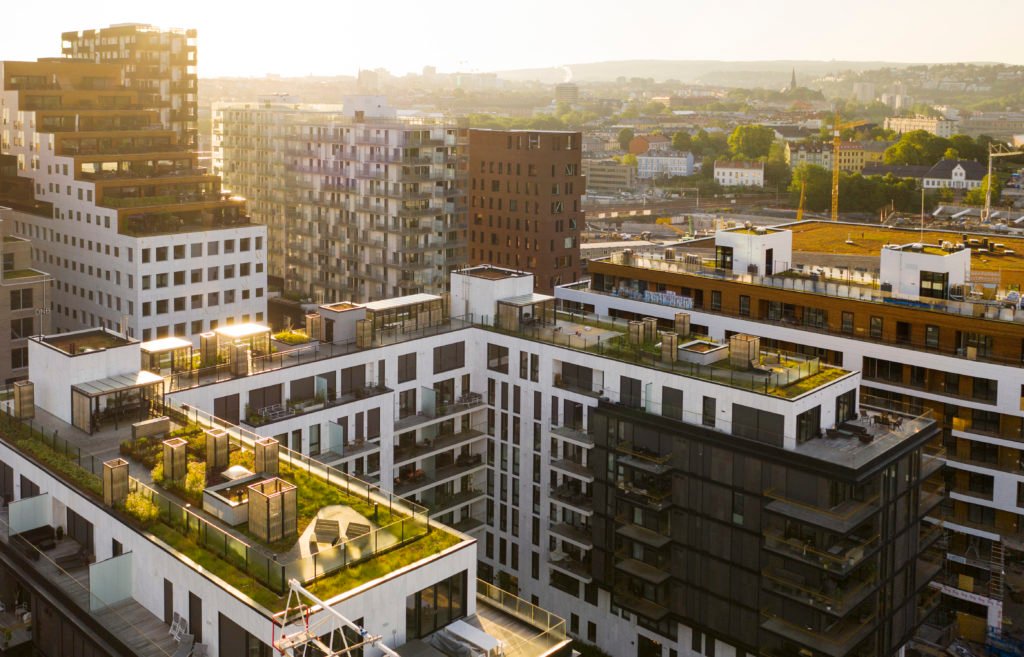
This image is property of www.standardindustries.com.
Factors to Consider when Implementing Green Roofs
Structural Capacity
Before implementing a green roof, it is crucial to assess the structural capacity of the building. Green roofs add significant weight to the structure, especially when they are fully saturated with water. A structural engineer should be consulted to determine if the building can support the additional load of the green roof. In some cases, retrofitting may be necessary to reinforce the building’s structural integrity.
Waterproofing
Proper waterproofing is essential for ensuring the longevity and effectiveness of green roofs. A robust waterproofing system should be installed to prevent water leakage and protect the building from moisture damage. Waterproof membranes, root barriers, and drainage layers are typically used to create a watertight seal. It is vital to work with experienced professionals who understand the intricacies of waterproofing green roofs.
Vegetation Selection
The selection of vegetation for green roofs is crucial for the success of the project. Factors such as climate, sun exposure, wind conditions, and maintenance requirements should be taken into consideration when choosing plants. Native and drought-tolerant species are often preferred, as they are well-adapted to the local environment and require less water and maintenance. Consulting with a horticulturist or landscape architect can help ensure the appropriate vegetation selection for a green roof.
Maintenance
Regular maintenance is essential to keep green roofs in optimal condition. This includes tasks such as watering, fertilizing, pruning, and weeding. It is crucial to establish a maintenance plan and allocate resources for ongoing upkeep. Some apartment buildings may choose to outsource maintenance to professional landscaping companies, while others may assign responsibilities to building staff or involve residents in communal gardening initiatives.
Expense
Implementing green roofs can be a significant investment for apartment buildings. Costs can include the installation of waterproofing systems, vegetation, irrigation systems, and ongoing maintenance. However, it is important to consider the long-term benefits and potential cost savings associated with green roofs, such as reduced energy bills and increased property value. Additionally, there may be local regulations and incentives that can help offset some of the expenses.
Implementing Green Roofs in Apartment Buildings
Retrofitting Existing Buildings
Implementing green roofs in existing apartment buildings often requires retrofitting. As mentioned previously, a structural assessment should be conducted to ensure the building can support the additional weight. If modifications are needed, they should be made to strengthen the structure before proceeding with the installation of the green roof. Waterproofing systems and drainage infrastructure should also be carefully integrated into the existing building.
Design Considerations for New Construction
For new construction, green roofs can be seamlessly integrated into the building design. An architectural and engineering team can work together to incorporate the green roof into the building plans from the beginning. This allows for careful consideration of structural capacity, waterproofing, and vegetation selection. By incorporating green roofs early in the design process, it becomes easier to optimize the performance and aesthetics of the green roof.
Local Regulations and Incentives
When implementing green roofs in apartment buildings, it is important to be aware of local regulations and incentives. Some cities or municipalities may have specific guidelines or requirements for green roofs, including minimum vegetation coverage or water runoff targets. Additionally, there may be financial incentives, grants, or tax breaks available to offset the costs of implementing green roofs. Understanding and utilizing these regulations and incentives can make the process more manageable and financially feasible.
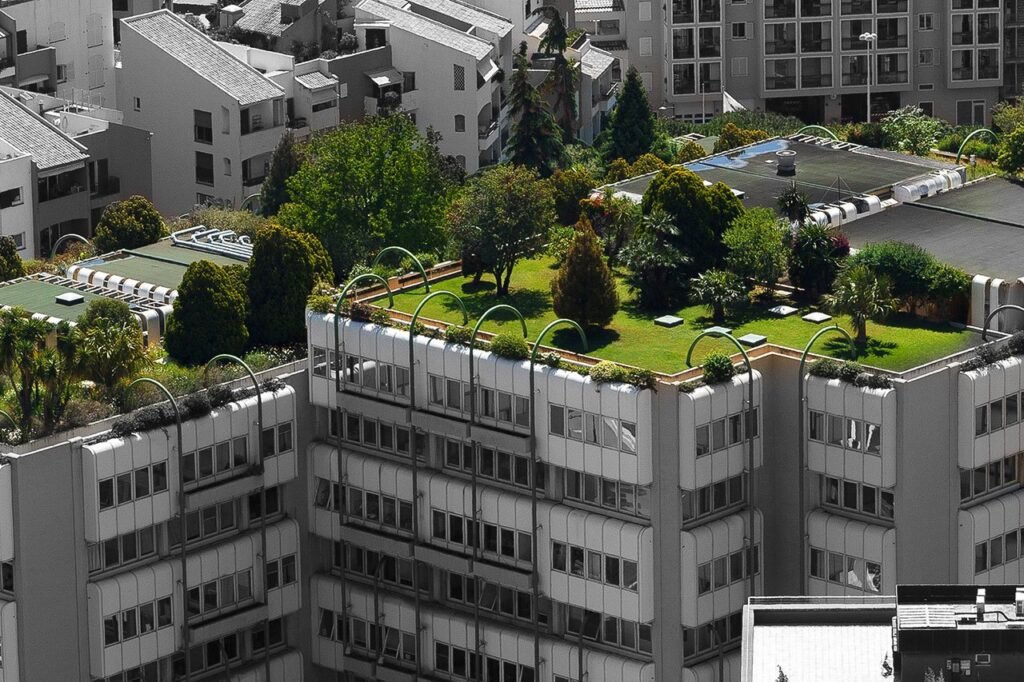
This image is property of www.usbiopower.com.
Case Studies: Successful Green Roofs in Apartment Buildings
Apartment Building A: Integration of Green Roof in Urban Setting
Apartment Building A is located in a dense urban area with limited green space. The building’s rooftop was transformed into an extensive green roof, covered with a variety of drought-tolerant plants. The green roof not only helped to reduce the building’s energy consumption but also provided a much-needed oasis for residents. The rooftop now serves as a communal area, featuring seating, walkways, and even a small vegetable garden. The integration of the green roof has greatly enhanced the quality of life for residents and improved the overall aesthetics of the building.
Apartment Building B: Maximizing Green Space for Resident Enjoyment
Apartment Building B was designed with a focus on creating a vibrant and lush green space for residents to enjoy. The building features an intensive green roof with a mix of trees, shrubs, and perennial plants. The rooftop provides ample space for residents to relax, exercise, and socialize. The green roof is designed with walking paths, seating areas, and even a rooftop garden where residents can grow their own vegetables. The integration of the green roof has not only improved the overall aesthetics of the building but also created a sense of community and well-being among the residents.
Maintenance and Care for Green Roofs in Apartment Buildings
Regular Inspections and Repairs
Regular inspections and repairs are essential to ensure the longevity and functionality of green roofs in apartment buildings. An inspection schedule should be established to check for any signs of damage, such as leaks, loose vegetation, or clogged drainage systems. Repairs should be promptly addressed to prevent further damage and maintain the waterproofing integrity of the roof. It is recommended to hire experienced professionals who specialize in green roof maintenance to carry out the inspections and repairs.
Irrigation and Fertilization
Proper irrigation and fertilization are crucial for the health and vitality of vegetation on green roofs. Depending on the climate and plant selection, regular watering may be necessary to provide the right amount of moisture to the plants. Irrigation systems should be efficient and properly calibrated to avoid overwatering or water wastage. Fertilization should be done with organic or slow-release fertilizers to minimize the risk of runoff and water pollution.
Weed Control
Weed control is an important aspect of green roof maintenance. Weeds can compete with the desired vegetation for nutrients and water, potentially compromising the health and appearance of the green roof. Regular weeding and the use of mulch can help suppress weed growth and maintain the aesthetics of the green roof. It is important to use weed control methods that are safe for the environment and do not harm the surrounding ecosystem.
Pruning and Trimming
Pruning and trimming are necessary to control the growth of vegetation on green roofs. This helps to maintain the desired shape and size of the plants and prevents overcrowding. Pruning also promotes air circulation and reduces the risk of disease and pest infestations. Regular pruning and trimming should be carried out by trained professionals to ensure the health and aesthetic appeal of the green roof.
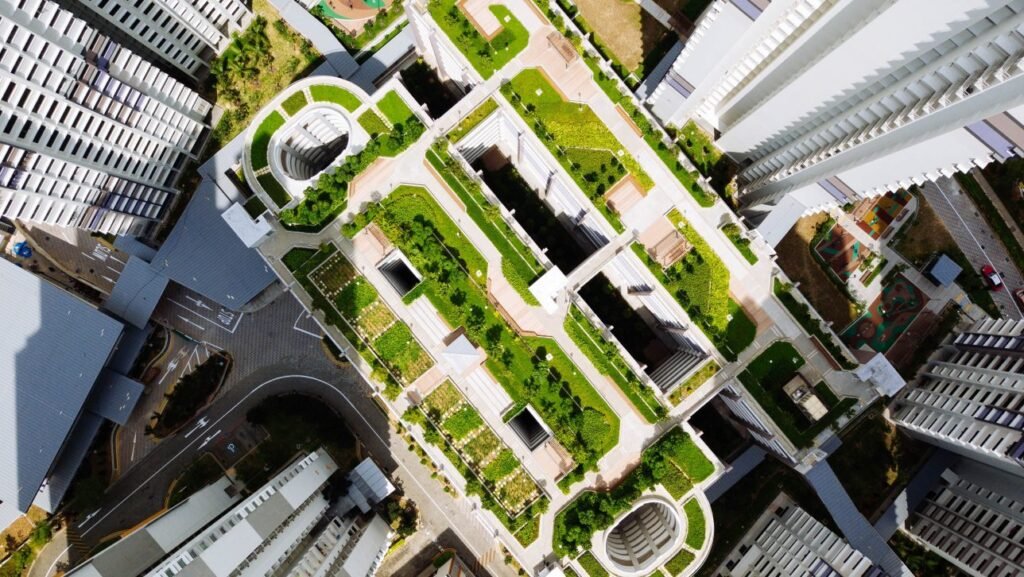
This image is property of news.ucdenver.edu.
Economic Considerations
Cost of Installation and Maintenance
Implementing green roofs in apartment buildings can involve significant upfront costs. The installation of waterproofing systems, vegetation, and drainage infrastructure can be expensive. Additionally, ongoing maintenance costs should be taken into account, including inspections, repairs, and irrigation. However, it is important to consider the long-term savings that can be achieved through reduced energy bills, longer lifespan of roofing materials, and potential tax incentives or grants for green roof implementation.
Return on Investment
While the initial costs of implementing green roofs may be high, the return on investment can be substantial. Energy savings from reduced heating and cooling needs can lead to significant cost reductions over time. Additionally, the extended lifespan of roofing materials can save money on future repairs or replacements. Green roofs can also increase the property value of apartment buildings, attracting environmentally conscious buyers or tenants and potentially commanding higher rental or sale prices.
Long-term Savings on Energy and Water Costs
Green roofs contribute to long-term savings on energy and water costs for apartment buildings. The insulation provided by the green roofs reduces the need for air conditioning and heating, resulting in lower energy bills. The water-retaining properties of green roofs reduce the demand for irrigation, resulting in lower water costs. These savings can accumulate over time and help offset the initial investment in green roof implementation.
Increased Property Value
Green roofs can significantly increase the property value of apartment buildings. Green spaces and sustainable features are highly sought after by environmentally conscious buyers or tenants. The aesthetic appeal, improved air quality, and energy-efficient nature of green roofs can make apartment buildings more attractive and desirable. This can lead to higher rental or sale prices, providing a return on investment for the green roof implementation.
Community Engagement and Education
Resident Participation
Community engagement and resident participation are vital for the success and maintenance of green roofs in apartment buildings. Residents should be encouraged to get involved in the care and maintenance of the green roofs, whether through communal gardening initiatives or participation in educational programs. By engaging residents, a sense of ownership and pride in the green roof can be fostered, creating a stronger sense of community within the apartment building.
Educational Programs and Workshops
Educational programs and workshops can be organized to raise awareness and educate residents about the benefits and maintenance of green roofs. These programs can cover topics such as water conservation, native plant selection, and best practices for gardening on green roofs. By providing residents with knowledge and skills, they can actively contribute to the care and sustainability of the green roofs in the apartment building.
Public Tours and Open Houses
Public tours and open houses can be organized to showcase the green roofs in apartment buildings to the broader community. This provides an opportunity to educate the public about the benefits of green roofs and inspire others to implement similar sustainable solutions. Public tours can also be an avenue for apartment buildings to engage with local schools, community groups, or environmental organizations, fostering partnerships and promoting environmental awareness.

This image is property of www.foampartner.com.
Challenges and Solutions
Structural Limitations
One common challenge in implementing green roofs in apartment buildings is the structural capacity of the building. Some older buildings may not have been designed to support the additional weight of a green roof. The solution is to conduct a thorough structural assessment and consult with a structural engineer to determine if modifications or reinforcements are needed. Retrofitting the building to increase its structural strength can overcome this challenge and make green roof implementation possible.
Waterproofing Issues
Waterproofing is another crucial aspect of green roof implementation. If not properly waterproofed, green roofs can lead to moisture damage, leaks, and costly repairs. The solution is to work with experienced professionals who can ensure the correct installation of a robust waterproofing system. Root barriers and proper drainage infrastructure should be incorporated to prevent water penetration and protect the building structure.
Selection of Suitable Plant Species
Choosing the right plant species for green roofs can be challenging, as the rooftop environment can be harsh with limited soil depth and exposure to sun, wind, and extreme temperatures. The solution is to consult with landscape architects and horticulturists who specialize in green roof design. They can help select plant species that are well-suited to the rooftop conditions, such as drought-tolerant or native plants, ensuring the success and longevity of the green roof.
Maintenance and Upkeep
Maintaining green roofs in apartment buildings can be a significant challenge, especially if proper maintenance plans and resources are not in place. Lack of regular inspections, repairs, pruning, and weeding can lead to the deterioration of the green roof. The solution is to establish a comprehensive maintenance plan and allocate resources for ongoing upkeep. This may involve hiring professional landscapers or involving residents in communal gardening initiatives.
Coordination with Building Management
Another challenge in implementing green roofs is coordinating with building management and ensuring their support for the project. Building management may have concerns about the upfront costs, ongoing maintenance, or the disruption caused during the implementation process. It is important to communicate the long-term benefits, cost savings, and potential increase in property value associated with green roofs. Building management should be involved in the decision-making process to address any concerns and ensure their commitment to the project’s success.
Conclusion
Green roofs offer numerous benefits for apartment buildings, including reduced energy consumption, improved air quality, reduced stormwater runoff, enhanced biodiversity, and extended lifespan of roofing materials. By selecting the appropriate green roof type and considering factors such as structural capacity, waterproofing, vegetation selection, maintenance, and expense, apartment buildings can successfully implement green roofs. Through retrofitting, thoughtful design considerations in new construction, and leveraging local regulations and incentives, green roofs can become a reality in apartment buildings, transforming urban spaces into thriving and sustainable environments. With proper maintenance and care, green roofs can provide long-term economic benefits, community engagement opportunities, and overcome various challenges. Green roofs are a sustainable solution that can enhance the quality of life for apartment residents while promoting environmental stewardship.

